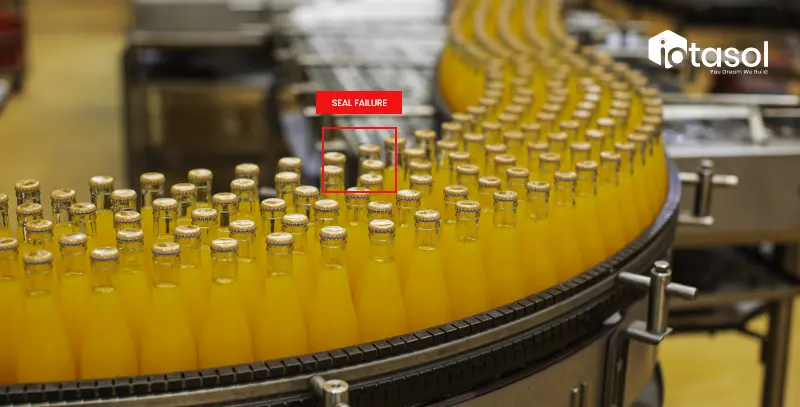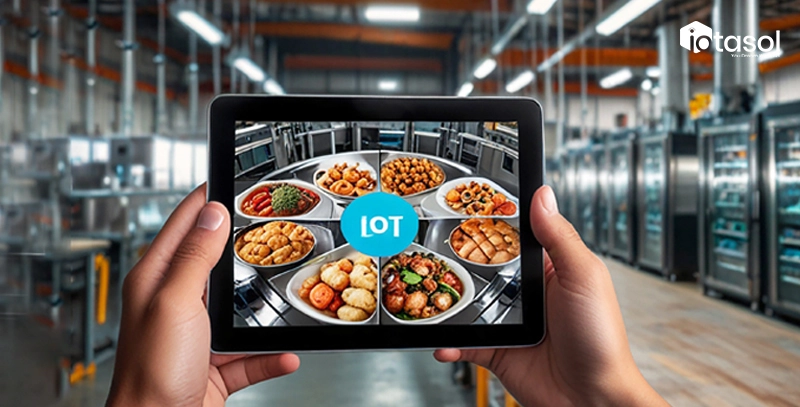Introduction
In the highly regulated packaged food industry, quality control is paramount. With consumer safety, brand reputation, and regulatory compliance at stake, manufacturers must ensure that each product meets stringent standards before reaching the market. However, traditional quality control methods can be challenging, involving high labor costs, the potential for human error, and significant production inefficiencies.
Fortunately, technology is transforming quality control processes through computer vision solutions for the packaged food industry. By integrating advanced technologies like computer vision, IoT, and AI, food manufacturers can achieve unparalleled accuracy, efficiency, and consistency in quality control. This article explores how computer vision enhances food packaging quality control and offers practical insights for food production leaders considering automation.
Understanding the Need for Quality Control Automation in Food Packaging
Food packaging quality control isn’t just a best practice—it’s an industry imperative. Consistent quality control ensures that each package complies with safety regulations, maintains brand integrity, and avoids costly recalls. However, traditional quality control methods often rely heavily on manual inspection, which can be time-consuming, inconsistent, and prone to errors.
With increased demand for efficiency and precision, the packaged food industry is rapidly turning to automation. Automated quality control solutions offer a way to minimize human error and reduce waste while maintaining high standards for each packaged product. Computer vision is at the forefront of these advancements, providing automated inspection and defect detection capabilities that streamline the quality control process.
What is Computer Vision, and How Does it Apply to Food Packaging?
Computer vision is an AI-driven technology that uses cameras and algorithms to interpret visual data. In Food Packaging, computer vision systems analyze images of food packaging to identify and flag defects with exceptional accuracy.
Acting as the “eyes of the production line,” computer vision provides 24/7 inspection capabilities, ensuring that each product meets quality standards without the limitations of human fatigue or oversight.
By capturing high-resolution images and processing them with AI algorithms, computer vision systems can detect issues in real-time, including misprints, seal integrity failures, and foreign objects. In effect, computer vision transforms quality control from a manual, reactive process to an automated, proactive one, ensuring that quality issues are addressed as they arise.
How Computer Vision Enhances Food Packaging Quality Control?
Computer vision automates food packaging quality control by identifying defects with speed and accuracy. Using AI-driven real-time analysis, it reduces human error, ensures consistent quality, and enhances regulatory compliance, helping manufacturers meet strict standards efficiently.

Real-Time Defect Detection Systems
Real-time defect detection is a critical advantage of computer vision solutions for the Packaged Food Industry. Using AI-powered visual inspection technology, computer vision systems analyze each package as it moves through the production line.
Example: A real-time defect detection system can identify and remove packages with defects like broken seals, misaligned labels, or incorrect weights before they reach distribution.
Benefit: This immediate action minimizes waste and prevents faulty products from reaching consumers, thereby protecting the brand’s reputation and ensuring consumer safety.
Automated Quality Control Solutions for Consistency and Accuracy
One of the biggest challenges in quality control is maintaining consistency across large production volumes. Computer vision helps manufacturers overcome this by providing automated quality control solutions that inspect every product with the same level of precision.
Analogy: Think of automated quality control as a “24/7 quality inspector” that never tires or misses small details. This continuous vigilance ensures that every product meets the same high standards.
Result: By reducing human involvement, manufacturers achieve more consistent and accurate quality control, minimizing the chances of product recalls or compliance issues.
High-Resolution Imaging for Enhanced Inspection
High-resolution imaging is essential for detecting micro-defects that are often missed by traditional inspection methods. Computer vision systems equipped with high-resolution cameras can capture even the smallest packaging imperfections, ensuring a higher level of quality assurance.
Benefit: These high-resolution images enable precision inspection technology to identify micro-defects like tiny label misalignments or minute contaminants, which are critical for maintaining quality standards in the food industry.
AI-Powered Defect Classification for Quality Assurance
AI-powered inspection systems enhance quality control by classifying defects based on severity, enabling manufacturers to prioritize and address quality issues systematically.
Example: By sorting packaging defects by type, computer vision can categorize defects as minor (such as a small label misalignment) or critical (such as a damaged seal). This classification allows quality assurance teams to focus on the most impactful issues first.
Benefit: This AI-driven defect detection process improves quality control precision and ensures that resources are allocated effectively.
IoT Integration for Continuous Monitoring

The Internet of Things (IoT) plays a complementary role in computer vision for manufacturing by enabling continuous monitoring and real-time data collection. IoT sensors provide valuable insights into production conditions that may impact packaging quality.
Example: IoT devices can monitor parameters like temperature, humidity, and line speed, all of which can influence packaging integrity.
Benefit: By integrating IoT data with computer vision, manufacturers gain real-time analytics that enhance their ability to maintain quality standards.
Key Benefits of Computer Vision Solutions for Food Packaging
Improved Quality Consistency
Automated quality control with computer vision ensures more uniform products by reducing the variability inherent in manual inspections. This consistency helps manufacturers deliver a high-quality product experience every time.
Impact: Uniformity across batches strengthens brand reputation and increases consumer trust.
Cost Savings Through Waste Reduction
One of the significant advantages of automation is its cost-saving potential. By detecting defects in real-time and removing defective products early, computer vision helps reduce waste and disposal costs.
Result: This efficiency leads to substantial cost savings, making computer vision a cost-effective quality control solution for manufacturers.
Enhanced Compliance with Food Production Standards
With increasingly stringent regulations, ensuring regulatory compliance in Food Packaging is more important than ever. Computer vision simplifies compliance by automating inspection processes, thus reducing the risk of errors or oversights.
Impact: Automated compliance helps manufacturers avoid costly penalties and ensures that all packaged products meet industry standards.
How to Implement Computer Vision in Food Packaging
For food production leaders considering computer vision, a systematic approach to implementation is essential for maximizing ROI.
-
Assess Current Quality Control Methods: Evaluate existing quality control practices to identify areas where computer vision could improve efficiency and accuracy.
-
Choose the Right Computer Vision Solution: Select a computer vision system tailored to your specific packaging requirements, whether for defect detection, quality assurance, or both.
-
Integrate IoT for Real-Time Insights: Pair computer vision with IoT devices to enable real-time monitoring and data collection.
-
Start with a Pilot Program: Begin with a smaller implementation to test the effectiveness of the system before scaling it across the production line.
Overcoming Challenges in Adopting Computer Vision for Quality Control
Adopting computer vision technology may raise concerns around implementation costs and employee acceptance. However, these challenges can be addressed with strategic planning:
-
ROI Demonstration: Showcasing the ROI of computer vision technology, such as waste reduction and improved quality, can help justify the initial investment.
-
Gradual Adoption: Begin with small-scale implementation and expand gradually. This phased approach helps employees become familiar with the technology and reduces resistance.
Conclusion
In today’s competitive packaged food industry, quality control is essential to maintain brand reputation, ensure regulatory compliance, and meet consumer expectations. Computer vision solutions for the packaged food industry offer a powerful, automated alternative to traditional quality control methods, providing real-time defect detection, high-resolution imaging, and AI-driven inspection that enhance efficiency and consistency. By embracing computer vision and IoT, food manufacturers can stay ahead of industry demands and achieve unparalleled quality assurance.
Ready to elevate your food packaging quality control? Contact iotasol today for a personalized demo and see how our computer vision solutions can help you achieve precision, consistency, and compliance in every package.
FAQ Section
-
How does computer vision work in quality control?
Computer vision systems capture high-resolution images of each package and analyze them using AI algorithms to detect defects. This image-based analysis enables automated, real-time quality control. -
What are the primary benefits of using computer vision in Food Packaging?
Computer vision improves consistency, accuracy, compliance, and cost savings by automating quality control and minimizing human error. -
Can computer vision detect all types of packaging defects?
While computer vision is highly effective at detecting visual defects, some complex issues may require additional inspection technologies for comprehensive quality control. -
Is computer vision suitable for small-scale food manufacturers?
Yes, computer vision solutions can be scaled to suit manufacturers of all sizes, making it a valuable tool even for smaller production operations.